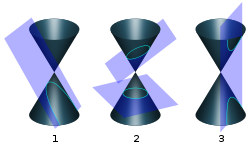This article includes a list of references, related reading, or external links, but its sources remain unclear because it lacks inline citations .(January 2026) |


The orbital plane of a revolving body is the geometric plane in which its orbit lies. Three non-collinear points in space suffice to determine an orbital plane. A common example would be the positions of the centers of a massive body (host) and of an orbiting celestial body at two different times/points of its orbit.
Contents
The orbital plane is defined in relation to a reference plane by two parameters: inclination (i) and longitude of the ascending node (Ω).
By definition, the reference plane for the Solar System is usually considered to be Earth's orbital plane, which defines the ecliptic, the circular path on the celestial sphere that the Sun appears to follow over the course of a year.
In other cases, for instance a moon or artificial satellite orbiting another planet, it is convenient to define the inclination of the object's orbit as the angle between its orbital plane and the planet's equatorial plane.
The coordinate system defined that uses the orbital plane as the plane is known as the perifocal coordinate system.
